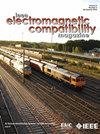谐波和超谐波电压畸变下的LED灯闪变评估
IF 2.5
3区 计算机科学
Q3 ENGINEERING, ELECTRICAL & ELECTRONIC
IEEE Transactions on Electromagnetic Compatibility
Pub Date : 2025-03-06
DOI:10.1109/TEMC.2025.3556986
引用次数: 0
摘要
超谐波(SH)背景失真被认为是LED灯产生闪烁的原因,但在文献中没有明确的证据。因此,本文的结构是研究谐波和SH范围内的背景畸变对广泛应用于住宅的低功率LED灯产生的光闪烁的影响。执行四种场景:第一种和第二种场景分别通过将LED灯暴露在具有谐波和谐波间电压分量的背景失真中来完成。第三和第四个场景分别探讨了频率为电网频率的整数倍和非整数倍的SH范围内电网电压畸变对LED灯闪烁的影响。研究表明,可见闪烁仅在场景2中出现,且可见闪烁效应与谐波间频率成反比关系。在场景1和场景3中,没有检测到可见的闪烁。在场景4中,灯光闪烁可以忽略不计。这些观察结果是在商用LED灯上进行的实验。然后给出了数学分析来解释四种情况下的观察结果。通过仿真研究验证了主要结果。本文章由计算机程序翻译,如有差异,请以英文原文为准。
LED Lamp Flicker Assessment Under Distorted Grid Voltage in Both Harmonic and Supraharmonic Ranges
Supraharmonic (SH) background distortions are blamed for light flickers produced from LED lamps with no clear evidence in literature. Consequently, this article is structured to investigate the effect of the background distortions in the harmonic and SH ranges on the light flickers produced from low power LED lamps that are widely used in residential applications. Four scenarios are performed: The first and second scenarios are done by exposing the LED lamp to a background distortion with harmonic and interharmonic voltage components, respectively. The third and fourth scenarios explore the impact of the grid voltage distortion in the SH range with frequencies that are integer and noninteger multiples of the grid frequency, respectively, on LED lamp flickers. The conducted study comes to the conclusion that visible flicker only appears for scenario 2, in which the visible flicker effect is in inverse relationship with the interharmonic frequencies. In both scenarios 1 and 3, no visible flicker is detected. In scenario 4, the light flicker is negligible. The observations are carried out experimentally on a commercial LED lamp. Then a mathematical analysis is provided to explain the observations in the four scenarios. The main outcomes are validated through a simulation study.
求助全文
通过发布文献求助,成功后即可免费获取论文全文。
去求助
来源期刊
CiteScore
4.80
自引率
19.00%
发文量
235
审稿时长
2.3 months
期刊介绍:
IEEE Transactions on Electromagnetic Compatibility publishes original and significant contributions related to all disciplines of electromagnetic compatibility (EMC) and relevant methods to predict, assess and prevent electromagnetic interference (EMI) and increase device/product immunity. The scope of the publication includes, but is not limited to Electromagnetic Environments; Interference Control; EMC and EMI Modeling; High Power Electromagnetics; EMC Standards, Methods of EMC Measurements; Computational Electromagnetics and Signal and Power Integrity, as applied or directly related to Electromagnetic Compatibility problems; Transmission Lines; Electrostatic Discharge and Lightning Effects; EMC in Wireless and Optical Technologies; EMC in Printed Circuit Board and System Design.

 求助内容:
求助内容: 应助结果提醒方式:
应助结果提醒方式:


